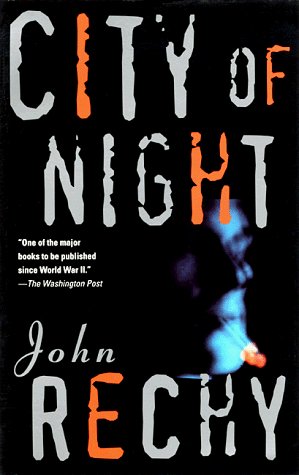- The Good: A seminal work of gay counterculture fiction full of fascinating characters
- The Bad: More interesting to analyze than to read for pleasure
- The Literary: Omitted apostrophes in speech and stream of consciousness style
A young man escapes his small life in El Paso and travels to Times Square and beyond, searching for himself and exploring the world by hustling in the seedy neon-lit underworld of male prostitution. First published in 1963, City of Night became a national bestseller and ushered in a new era of LGBTQ fiction. I can see how this book was a breath of fresh air for the youths desperate for a dark and beautiful non-conformist way of life.
Written as a stream of consciousness in the style of an exposé, the narrator focuses less on his own journey and instead features a seemingly unending parade of characters, including his clients, other hustlers, and other members of the hustle community. There is plenty of sex and sexual peculiarities, but it’s not erotic. There’s also no sense of urgency or build up or movement throughout the novel. To enjoy this fully, you have to let go and immerse yourself in a place and time that seems like it only exists in the movies.
The characters are just so colorful—wild and free and tragic and desperate. My favorite are the drag queens, who have never fit into a society that hates them but only burn brighter because of it. At one point, during a Mardi Gras parade, the narrator asks one beautiful young drag queen why she’s smiling, and she responds, “because I am going to die.” There are also some specifically memorable characters, including the “mother” who wants to feed her tricks, the bed-ridden agent who collects pictures of his favorite “angels”, the aging fallen actor, and the frightened straight man exploring his sexuality while his wife and kid are at home.
Unfortunately, the character arc of the narrator is minimal. He’s an observer, and little impresses upon him. From the start, he maintains that he’s not gay, that one day he’ll quit hustling, settle down with a wife in the suburbs and have kids. He admits about halfway through the novel that he’s desperate to feel wanted, and he’s most satisfied when someone is willing to pay to be with him. There’s one chance for redemption at the end of the novel when one of his customers finds some vulnerability, and the narrator imagines that maybe he could receive and give love freely. But the moment passes, and our narrator moves on. This is unsatisfying for fiction but certainly purposefully done, as if the city of night is an unending self-perpetuating organism.
The book doesn’t feel like fiction for several reasons, one of which is that it’s also rooted in reality. Our protagonist manages to escape the Cooper Donuts Riot in 1959 in LA, during which the LAPD harassed and arrested a number of gays, transgender people, and drag queens who loitered there. This only adds to the feeling that we’re exploring the seedy underbelly of a city at night, a thrilling forbidden fruit that’s at once sexy and frightening. It’s also fascinating to get a glimpse of the urban gay scene before the Stonewall Riots of 1969 or the HIV/AIDS crisis of the 1980s.
Compared to the out and proud LGBTQ culture of today, this book seems, not quite tame, but certainly not as radical. It’s a fascinating portrait of the alienated gay culture of the 1960s, as the beatniks gave way to the hippies, but this is darker than both of those movements. I can see why James Baldwin called Rechy, “the most arresting young writer I’ve read in a very long time. His tone rings absolutely true, is absolutely his own.” This book could easily be categorized along with Jack Kerouac and William S. Burroughs, as Americana from a gay perspective. But I also see in this the striking combination of outcasts a sense of desperation and search for truth and beauty similar to the Bohemian movement in Paris in the late nineteenth century. I find myself wanting to revisit the work of Toulouse-Lautrec as I read this.
If you’re looking for an unpolished antidote to The Brady Bunch or Mad Men era, ripe with exciting counterculture, or want to explore the formative gay literature, then this is for you!
